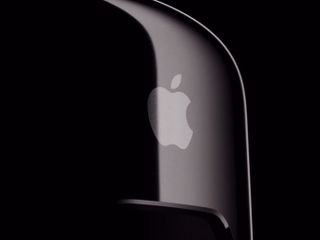Should you buy (or upgrade to) a 2017 Mac Pro?

After years of languishing in a dark, sad cave of a webpage on Apple's site, the 2013-era Mac Pro has at last seen a small spec bump. But with new Mac Pros on the horizon, is it worth buying this upgraded Mac Pro?
What's been upgraded?
The external casing of the Mac Pro remains the same for its 2017 update: The only bits that have been upgraded are the computer's CPU and GPU.
Before, $2999 would get you a 3.7 GHz Intel 4-core Xeon processor; now, for the same price you'll get a 3.5 GHz 6-core processor with 12MB of L3 cache.
You'll also see an upgrade to the Mac Pro's internal graphics cards — moving from AMD's D300 dual graphics processors to the company's D500 chips with 3GB of GDDR5 VRAM.
As before, you can spend more to upgrade the Mac Pro to a 2.7GHz Intel 12-core Xeon processor, graphics to dual AMD FirePro D700 GPUs with 6GB of GDDR5 VRAM, and up to 64GB of 1866MHz DDR3 ram.
It's worth noting that these upgrades aren't new components for the Mac Pro — since 2013, you've been able to build the Mac Pro to order with higher-core Xeon processors and FirePro D700 GPUs. Instead, while it works on the next generation of Mac Pro, Apple has essentially discounted formerly paid upgrades by $1000+, making them the default option for new buyers.
Everything else about the Mac is the same: You'll still get four USB 3 ports, two Thunderbolt 2 ports, Gigabit Ethernet, headphone port and an SDXC card slot.
Master your iPhone in minutes
iMore offers spot-on advice and guidance from our team of experts, with decades of Apple device experience to lean on. Learn more with iMore!
So, with these changes, is the 2017-updated Mac Pro worth a purchase? It depends on what you need in your office.
Should you upgrade from an earlier 2013-era Mac Pro?
No. Other than a "free" upgrade to CPU and GPU, there's really nothing new or exciting about this version of the Mac Pro. If you need the extra processing power, you should sooner look for used or refurbished Mac Pros than buy a new one outright.
Should you upgrade from an older iMac, MacBook Pro, or other Mac computer?
This question is trickier and requires diving into more detailed questions about what you do for your work, and how well your current computer is holding up.
Do you absolutely need the power of a Mac Pro?
This is the biggest question to answer when contemplating a Mac Pro. While it will never match the Pro byte for byte in processing speed, the 4K and 5K iMac have greatly loosened the definition of what a "pro" user needs — if you don't have need for extreme rendering power, you might be better off with a new iMac.
What, exactly, do I mean by rendering power? I'll let former iMore editor Peter Cohen explain:
Xeon chips have gobs of L3 cache, which can greatly speed up operations. They're designed to run cooler at high load, and they also support a special type of memory called Error Correcting Code (ECC) that's better for computational operations where you can't afford any sort of error: Scientific work, for example. Six-core means the processor is capable of doing six times the work for applications that make use of multithreading technology, and that encompasses a wide swath of what your Mac does in the course of a day. The more cores the Mac has, the more efficiently it can perform some tasks that are optimized for this sort of CPU.Practical examples include encoding video, compressing and decompressing files, compiling code and many other operations.
While you can certainly edit video on the 4K and 5K iMac line — I do frequently — if you're planning on regularly rendering large batches of content, or work in the 3D space, the Mac Pro's Xeon cores are better for your activities.
Can you afford to wait for the new Mac Pro?
The Mac Pro's recently released speed improvements are just one part of Apple's evolved pro Mac strategy — the company is currently working on a brand new component-based Mac Pro, though it has yet to provide a timeline beyond "not this year."
If you're really interested in the power of a Mac Pro desktop but you can afford to wait, do so — if the new Pro doesn't come out in 2018, you at least might be rewarded with further price cuts on the old models.
And if you don't need the power of a Mac Pro but can afford to wait a few months, you'll find new iMac options — including models built specifically for higher-end pro users.
If you absolutely can't wait for Apple's revised Mac Pro or iMac line, ask yourself: Are you a graphics professional who can work in both environments? If this is true for you, but you can't wait a year (or more) for Apple's new pro desktop system, consider purchasing a less expensive PC workhorse to pinch-hit for you while you wait for new Mac systems.
Does your workflow take advantage of OpenCL, or CUDA?
Over the last few years, many 3D design and effects companies have started taking advantage of NVidia's CUDA GPU parallel programming and computing system — which relies, of course, on NVidia's chips to work properly. The Mac Pro, in contrast, uses dual AMD FirePro graphics cards, which are optimized for OpenCL. These are still heavy-duty workhorse cards, but they may not work as efficiently or effectively with software optimized for CUDA graphics cards.
Do you want upgradeability?
The 2013-chassis Mac Pro is designed to be sleek, small, and gorgeous — but upgradeable it is not. If you want to buy a machine you plan to upgrade over the years, best to wait for Apple's upcoming Mac Pro line or consider an Apple competitor in the meantime.
Do you have existing external peripherals?
Is your office filled with USB 3 peripherals and Thunderbolt 2 cables, or have you upgraded to USB-C and Thunderbolt 3? For companies that still rely on older peripherals, the current Mac Pro may be a better option than a 5K iMac or the eventual redesigned Mac Pro, which will likely offer USB-C and Thunderbolt 3 as standard ports.
Do you need a 5K display?
The current Mac Pro can drive three 4K or six standard-resolution displays, but it won't be able to reliably connect to any monitor that uses Thunderbolt 3 like LG's 5K wide-color display. As such, if you need higher-resolution or wide-color displays for your work, you should make sure the current Mac Pro can support it.
Bottom line: Should you upgrade?
As of right now, I would only recommend the current 2013-chassis Mac Pro to:
- Those running an older system who can't afford to wait to upgrade
- Those who need huge rendering power
- Those with many Thunderbolt 2 and USB 2 and 3 peripherals
I wouldn't recommend the Mac Pro to:
- Current 2013-era Mac Pro users
- Those who want upgradeability in their machines
- Anyone who plans to use USB-C peripherals
- Those who want to hook up a wide color display
- Those who want the latest and greatest technology
What about you, readers? If you're in the market for a Mac Pro, are you going to wait until Apple's new redesign or the next iMac, or pull the trigger and get an upgraded 2013-era model? Let us know in the comments.
Serenity was formerly the Managing Editor at iMore, and now works for Apple. She's been talking, writing about, and tinkering with Apple products since she was old enough to double-click. In her spare time, she sketches, sings, and in her secret superhero life, plays roller derby. Follow her on Twitter @settern.
Most Popular






